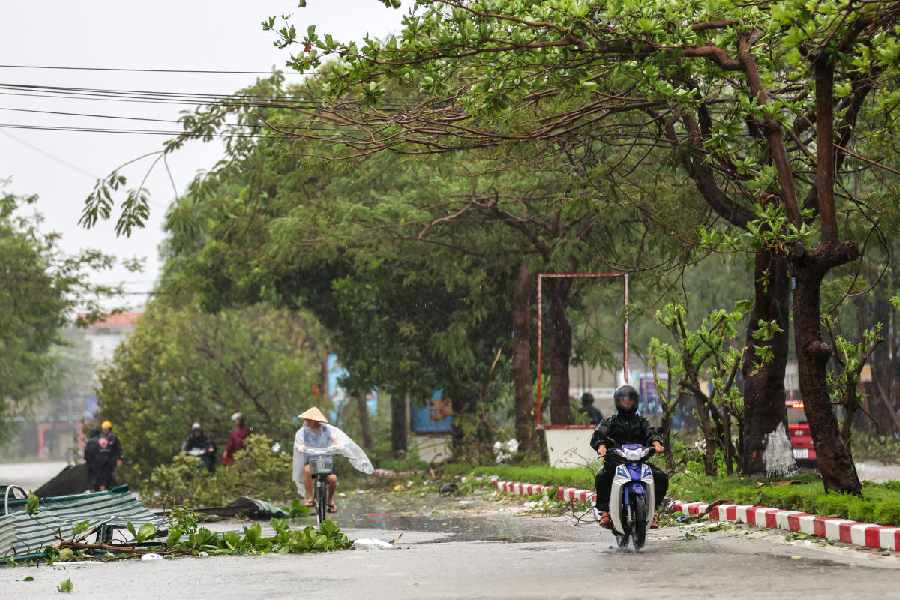 |
| Numi flowering teas come in elaborate designs that use lilies, chrysanthemum, hibiscus, rose and lavender |
The scene is set — the table is the stage, the water carafe or decanter is the prop and a blooming tea bud, the protagonist. When the bud tea is placed inside the carafe and piping hot water is poured into it, a startling transformation begins to unfold. As steam spirals through the jar, a light-coloured stain begins to suffuse the water and the dried bud begins to bloom. The magic of bud or flowering tea will play itself out over the next five minutes. This is visual drama at its best and for those who enjoy bar tricks, this tea trick is mesmerising.
This is obviously not just any old tea. Blooming tea (or dancing leaves) is currently the tea of choice for connoisseurs and is gaining ground among tea drinkers who enjoy light-bodied teas. Most of this tea is made — where else — in China.
Puneet Saigal, director of beverage and food at Crowne Plaza Today, Okhla, New Delhi, feels that the visual drama works in favour of the light-bodied, green or white flowering tea buds. “We strategically place these teas in our pasty shop and at least 10 guests a day inquire about what we call underwater fireworks,” says Saigal.
 |
| A box of Newby Teas can be ordered online as well as over the phone; Pic by Rupinder Sharma |
So, is it tea or is it a dried flower? Artistically hand-crafted, each white or green tea bud is picked with its moistness intact. Then it’s loaded with approximately 5gm to 8gm of tea leaves and is set into a fresh flower and sewn using a cotton thread into a variety of shapes, rosettes and bundles. It’s then left to dry naturally in the sun (as opposed to induced heat-drying that reduces the flavour of the bud). The flowers of choice include jasmine, chrysanthemum, rose, daisy, lily and others.
What makes these teas lighter is that the buds are picked when they are young. So, they are perfect for someone who isn’t looking for a caffeine kick.
Clearly, this is not a tea that you can order to-go. You must wait and watch the bud blossom.
At first you’d think this is an expensive, niche tea but Amit Mehta, co-owner of Chado Tea India, dispels the notion. “The per cup cost is negligible since you can re-infuse the bud with more water. It works out to be as cheap as any green or white tea cup,” he says. One tea bud is good for a couple of hot water refills and gives more than just one cup (about 250ml).
 |
| Chado Tea offers as many as seven bud varieties including white jasmine, jasmine rosette and lychee flower basket |
What’s more, these teas are packed with antioxidants and are extremely low on caffeine content. Restaurant Thai High in Delhi serves up at least 35-40 buds a day. “The tea cuts out the spiciness of the dishes,” says the restaurant’s general manager, Prashant Singh.
Jasmine buds are a hot favourite at The Westin Gurgaon’s coffee shop, Seasonal Tastes (priced at Rs 200 per bud) and at Thai High (Rs 175 per bud). Other popular buds at Thai High include chrysanthemum, daisy and dragon pearl (green tea in combination with three flowers).
Ahmed Rahim, CEO and co-founder of the American brand, Numi Organic Tea, sources flowering teas from Chinese tea gardens in Yunnan (in the south-west). Rahim says some shapes and flowers take longer to sew together with the tea buds. The elaborate designs that use lilies, chrysanthemum, hibiscus and osmanthus are even harder to sew and sometimes it takes tea artisans a whole day to sew two buds given their intricacy.
 |
| Restaurant Thai High in Delhi serves 35 to 40 flowering tea buds a day; Pic by Rupinder Sharma |
Numi sells its teas through its website www.numitea.com for approximately Rs 1,750 ($35) a box. Packages like the Dancing Leaves Flowering Tea Set include a glass teapot and a variety of buds like starlight rose, dragon lily, lavender dream and golden jasmine.
Debraj Banerjee, head of marketing, India, Newby Teas of London, says: “The water must be fresh and boiled to about 70°C or 80°C.” The flower buds should be placed in a clear glass pot that should be filled with steaming water to the brim. “Water level plays a very important part in the process,” says Banerjee.
Crowne Plaza’s Saigal says that flowering tea doesn’t require acc-ompaniments like milk, though honey isn’t a strict no-no. Banerjee adds that an increasing number of consumers are taking to this tea as they can consume it without the additional calories from milk or sugar.
A box of 20 Newby tea buds cost between Rs 3,200 and Rs 4,200 and can be bought through sales@newbyindia.com or over the phone (033 32505667).
 |
| Pic by Rupinder Sharma |
And if you don’t want to buy a box, you can always go for the loose tea from Chado Tea. The seven bud varieties that you can choose from — White Jasmine Moon, Red Mudan, Green Mudan, Jasmine Rosette, Little Calabash Green, Lychee Flower Basket and Three Brothers’ tea — cost between Rs 650 and Rs 950 per hundred gram. The top seller is White Jasmine Moon (with white tea, jasmine and chrysanthemum) and the Lychee Flower Basket (with green tea and jasmine).
The general rule for buying flowering tea (loose or packaged), says US-based master-blender David De Candia, director of tea, The Coffee Bean & Tea Leaf, is to look for an expiration date. “One must also pick buds that are tightly packed. The tighter the bud the longer an artisan must have spent on it,” Candia adds.
So, you may have to wait for the flower to bloom but it’s worth the wait.











